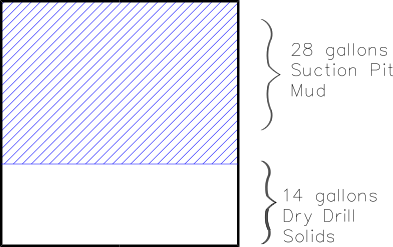Mud to Cuttings Ratio: Measuring Mud Lost with Cuttings Discarded by SCE
Mud to Cuttings Ratio: Measuring Mud Lost with Cuttings Discarded by SCE
Controlling fluid related drilling costs depends on having accurate data about the volume of drilling fluid that “floods over” or is “retained on” or “piggy backs with” drill cuttings sent to disposal from solids control process equipment (SCE). The Mud to Cuttings Ratio (MCR) is based on wet cuttings density. It is also quickest, easiest, and most cost-effective way to collect mud loss data.
What is Mud to Cuttings Ratio?
MCR is a ratio that quantifies the volume of drilling fluid lost when drill cuttings are discarded by shale shakers. The ratio is determined by measuring the density difference between suction pit mud and the wet cuttings discard. The test is based on density, but MCR data is reported as a volumetric ratio.

An MCR of “2:1” means the sample is a mixture of 2 parts mud and 1 part “dry cuttings”. For example, mixing 28 gallons of drill mud with 14 gallons of dry drill cuttings creates a volume of one barrel with an MCR of 2:1.
How is MCR calculated?
The term “dry cuttings” means drill cuttings with no drilling fluid in contact with them. Imagine cuttings that have been chipped from the downhole formation while drilling with dry air. The term “wet cuttings discard” means the mixture of dry cuttings and drilling fluid discarded by a shale shaker or other processing equipment.
In all cases, the “wet cuttings discard” will be heavier than the mud pumped downhole. This difference in density means a “weight-up formula” can be used to determine MCR. Cutpoint Inc has developed phone apps to simplify the calculations and the apps are readily available on Android and Apple app stores.
Only a single field measurement of wet cuttings density needs to be made to calculate the MCR once a discard sample is collected. This is because suction pit mud weight is always known. Accurate measurement of the density of wet cuttings is best accomplished with an indirect measurement of cuttings volume. Since most cuttings are not liquid enough to be self-leveling, direct volume measurements can be difficult to do accurately. A cuttings volume measurement is best performed by adding cuttings to a graduated cylinder that has been partially filled with liquid. The displacement of the pre-filled liquid enables cuttings volume to be determined “indirectly”. The Cutpoint MCR Kit™ is designed to simplify measurement of cuttings density under field conditions.
MCR Advantages
The MCR method works equally well for water-base and oil-base fluids. Compared to retort methods, MCR data offers significant time and labor savings. MCR data is more accurate because a large sample volume is used. An MCR analysis takes less than 10 minutes giving solids control technicians real-time data that can be used to optimize equipment and verify cost savings from cuttings drying equipment. Additionally, MCR data can be used to quantify the savings when the mud discarded from shale shakers and other processing equipment is reduced.
